TDWI Best Practices Reports
TDWI’s Best Practices Reports are designed to educate technical and business professionals about new business intelligence technologies, concepts, or approaches that address a significant problem or issue. Research for the Best Practices Reports is conducted via interviews with industry experts and leading-edge user companies, and is supplemented by a survey of business intelligence professionals.
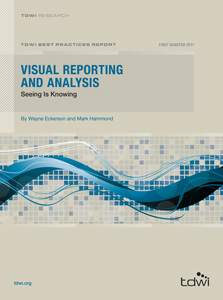
January 3, 2011
Data visualization is increasingly an essential element of
business intelligence (BI). No longer restricted to specialized
applications, data visualization in the form of charts, maps,
and other graphical representations is enabling business
users to better understand data and use it to achieve tactical
and strategic objectives.
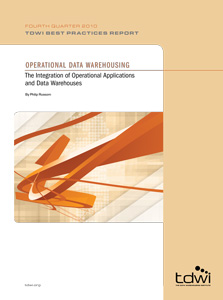
October 1, 2010
This report gives readers a jump-start on their journey toward operational data
warehousing by describing its enabling technologies and real-world business use cases, providing useful planning information for both business and technical managers.

July 1, 2010
The current economic downturn has accentuated the need among business intelligence (BI) teams to do “more with less.” With budgets cut or flat, most BI teams have been forced to innovate and find new ways to deliver projects more efficiently.
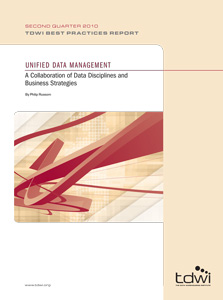
April 1, 2010
In most organizations today, data and other information are managed in isolated silos by independent teams using various data management tools for data quality, data integration, data governance and stewardship, metadata and master data management, B2B data exchange, content management, database administration and architecture, information lifecycle management, and so on. In response to this situation, some organizations are adopting what TDWI calls unified data management (UDM), a practice that holistically coordinates teams and integrates tools. Other common names for this practice include enterprise data management and enterprise information management. Regardless of what you call it, the “big picture” that results from bringing diverse data disciplines together yields several benefits, such as cross-system data standards, cross-tool architectures, cross-team design and development synergies, leveraging data as an organizational asset, and assuring data’s integrity and lineage as it travels across multiple organizations and technology platforms.
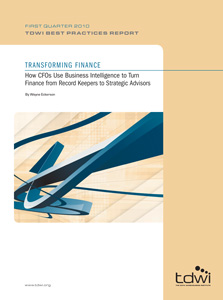
January 1, 2010
The finance department sits at the information nexus of the organization. It regularly collects financial and non-financial data from every business unit and consolidates that information into summary and detailed management reports. Finance can therefore be a powerful agent of organizational change. It can leverage the information that it collects to assist executives and line of business managers to optimize processes, achieve goals, avert problems, and make decisions.
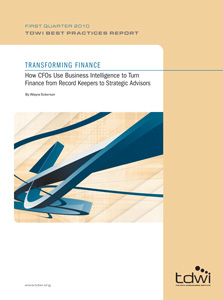
December 28, 2009
Forward-thinking finance departments have figured out how to transform themselves from back-office bookkeepers to strategic advisors by partnering with the business intelligence (BI) team.
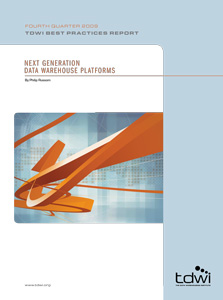
October 1, 2009
If you’re a data warehouse professional—or you work closely with one—you’ve probably noticed the many new options for data warehouse platforms that have appeared this decade. We’ve seen the emergence of new categories of data warehouse (DW) platforms, such as data warehouse appliances and software appliances. A new interest in columnar databases has led to several new vendor products and renewed interest in older ones. Open source Linux is now common in data warehousing, and open source databases, data integration tools, and reporting platforms have come out of nowhere to establish a firm foothold. In the hardware realm, 64-bit computinghas enabled larger in-memory data caches, and more vendors now offer MPP architectures. Leading database vendors have added more features and products conducive to data warehousing.
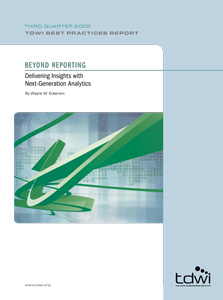
July 1, 2009
Webster’s Revised Unabridged Dictionary defines analytics as “the science of analysis,” and analysis as “the tracing of things to their source, and the resolving of knowledge into its original principles.” From a business perspective, these definitions imply that analytics is about understanding the root causes of business events and conditions. The upshot, of course, is that business people, armed with insights, will make the right decisions and take the appropriate actions to further their organizations’ tactical and strategic goals.
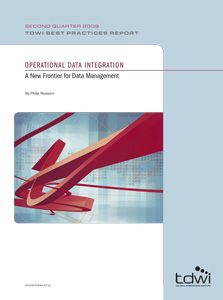
April 1, 2009
The amount and diversity of work done by data integration specialists has exploded since the turn of the twenty-first century. A lot of the growth comes from the emerging practice of operational data integration, which is usually applied to the migration, consolidation, or synchronization of operational databases, plus business-to-business data exchange.